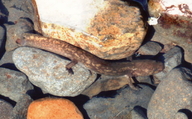|
Dicamptodon copei Nussbaum, 1970
Cope's Giant Salamander | family: Dicamptodontidae genus: Dicamptodon |
 © 2006 William Flaxington (1 of 20) |
|
|
|
Description The dorsum is brown with little mottling, often with yellowish tan patches. The venter of young individuals is white and in older individuals it is bluish gray. The morphology is typical of stream-dwelling larval salamanders with short, bushy gills and a low tail fin that extends onto the body, forward of the hind limb insertion. Eyes are lidless (Petranka 1998). Distribution and Habitat Country distribution from AmphibiaWeb's database: United States U.S. state distribution from AmphibiaWeb's database: Oregon, Washington
Dicamptodon copei inhabit cold, fast-flowing streams in humid, coniferous forests. Individuals may be found under rocks and woody debris (Petranka 1998). Life History, Abundance, Activity, and Special Behaviors Dicamptodon copei feed on a variety of aquatic invertebrates and also small fish (trout and sculpin), eggs and tadpoles of tailed frogs (Ascaphus), and smaller larval Dicamptodon (Nussbaum et al. 1983). Predators are garter snakes (Thamnophis), water shrews (Sorex palustris), and D. tenebrosus (Nussbaum 1970; Nussbaum et al. 1983; Loafman and Jones 1996). Larvae may emerge from streams on particularly wet nights (Nussbaum et al. 1983) Larva Trends and Threats Comments
References
Daugherty, C. H., Allendorf, F. W., Dunlap, W. W., and Knudsen, K. L. (1983). ''Systematic implications of geographic patterns of genetic variation in the genus Dicamptodon.'' Copeia, 1983(3), 679-691. Edwards, J.L. (1976). "Spinal nerves and their bearing on salamander phylogeny." Journal of Morphology, 148, 305-328. Good, D.A. (1989). "Hybridization and cryptic species in Dicamptodon (Caudata: Dicamptodontidae)." Evolution, 43, 728-744. Leonard, W.P., Brown, H.A., Jones, L.L.C., McAllister, K.R., and Storm, R.M. (1993). Amphibians of Washington and Oregon. Seattle Audubon, Seattle. Loafman, P., and Jones, L. (1996). ''Dicamptodon copei (Cope's Giant Salamander). Metamorphosis and predation.'' Herpetological Review, 27, 136. Nussbaum, R. A. (1970). "Dicamptodon copei, n. sp., from the Pacific Northwest, U.S.A. (Amphibia: Caudata: Ambystomatidae)." Copeia, 1970, 506-514. Nussbaum, R. A. (1976). "Geographic variation and systematics of salamanders of the genus Dicamptodon Strauch (Ambystomatidae)." Miscellaneous Publications of the Museum of Zoology, University of Michigan, 149, 1-94. Nussbaum, R. A. (1983). ''Dicamptodon copei Nussbaum. Cope's Giant Salamander.'' Catalogue of American Amphibians and Reptiles. Society for the Study of Amphibians and Reptiles, 334.1-334.2. Nussbaum, R. A., Brodie, E. D., Jr., and Storm, R. M. (1983). Amphibians and Reptiles of the Pacific Northwest. University of Idaho Press, Moscow, Idaho. Petranka, J. W. (1998). Salamanders of the United States and Canada. Smithsonian Institution Press, Washington D.C. and London. Originally submitted by: Meredith J. Mahoney (first posted 2000-01-17) Edited by: M. J. Mahoney, Michelle S. Koo (2022-08-18) Species Account Citation: AmphibiaWeb 2022 Dicamptodon copei: Cope's Giant Salamander <https://amphibiaweb.org/species/3865> University of California, Berkeley, CA, USA. Accessed Mar 31, 2025.
Feedback or comments about this page.
Citation: AmphibiaWeb. 2025. <https://amphibiaweb.org> University of California, Berkeley, CA, USA. Accessed 31 Mar 2025. AmphibiaWeb's policy on data use. |



 Raffaëlli Account
Raffaëlli Account Map of Life
Map of Life